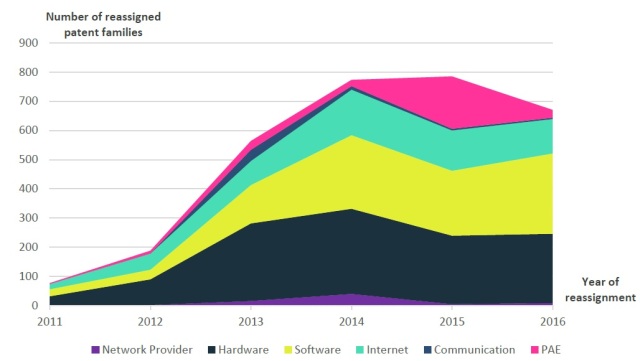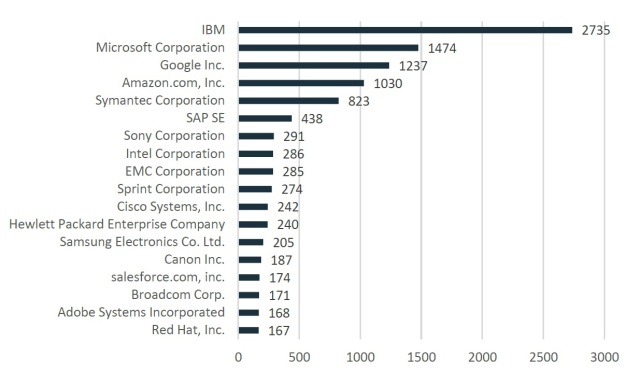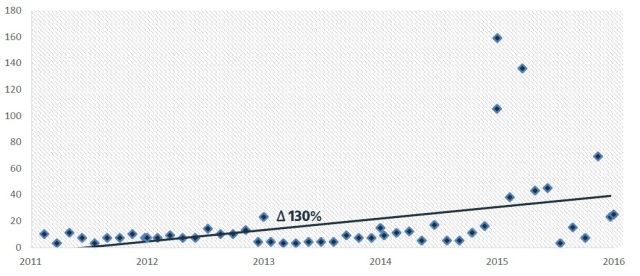Cloud Computing describes a type of Internet-based computing that provides access to shared computer processing resources. Cloud users store and process data to run diverse sets of software applications on shared computing systems. Cloud computing allows to run performance intensive processes on demand. This avoids up-front infrastructure costs and possibilities to scale up or scale down systems as to user traffic. Pay as you go models enable users to quickly get applications up and running.
The number of applications that run on cloud infrastructures is constantly growing. Market research reports predict worldwide cloud computing spending to drastically scale in the upcoming years.[1] In this regard the number of solution providers has been constantly increasing and the market develops to be more and more competitive.
Companies increasingly compete on innovative technologies that e.g. enable the efficient scaling up of a virtual machine, the quick deployment of data or the rapid recovery of applications. Such innovative technologies are exceedingly patented to allow patent owners to secure future technological areas, to demand royalty payments from other service providers or, equally likely, to ward off claims made against cloud providers by aggressive patent-holders.
We have used IPlytics Platform to perform an extensive keyword[2] search in worldwide filed patents’ titles, abstracts and claims to identify the strongest patent holders in the cloud computing space. In total our search identifies over 26,000 granted cloud computing patent families. 95% of these patent families have been filed in the past four years (2013-2017). Results show that the landscape of cloud computing patent owners is very diverse. Figure 1 illustrates that the three strongest patent holders IBM, Microsoft and Google altogether filed more than 5,000 patent families that have been granted in the past years. Sony, SAP, Samsung and Cannon are the only non-US companies among the top patent owners.
Not only the filing of new patent families has been increasing, but also the trade of patents has been growing in the recent years. Figure 2 illustrates the number of patent family transfers between 2011 and 2016. Numbers of yearly patent transfers peaked in 2015 with about 790 transferred unique patent families.

Figure 2: Number of reassigned cloud computing patent families as to main industry of the buying entity and as to year of reassignment
To ensure “bare” patent transfers among independent companies we differentiate the applicant and new owner company with regard to the highest parent company. We cleaned out cases, where the former and new owners were subsidiaries of the same parent corporation. Such reassignments are likely to result from fiscal optimization and strategic motives at the corporation group level. We label them as “internal” transfers if they take place between established entities of the same group, and as “acquisition” if they immediately follow the acquisition of the initial patent owning entity by the group.
Figure 2 only takes into account “bare” patent transactions and differentiates the patent transfer deals as to the buyer’s main industry of operation. The main industry refers to the main business service or product marketed by the applicant. The largest buyers in the software industry are SAP, Microsoft, McAfee and Adobe, the largest buyers in the Hardware industry are Intel, HP, Ricoh Company and Lenovo. The largest buyers in the Internet industry are Google, Amazon and Facebook, the largest buyers that are in the licensing and assertion business PAEs (Patent Assertion Entities) are Intellectual Ventures, Rovi Corporation and Dynamic Invention.
While the upsurge of patent acquisitions has consistently been increasing among the Hardware, Software and Internet industries, the share of patent family acquisitions by PAEs especially increased in 2015 and 2016. Figure 3 illustrates monthly patent transfers to PAEs. On average these transfers have been increasing since 2011 by 130%.
PAEs often acquire patents in technological areas that will likely become strategically important for future markets. The increasing number of patent acquisitions in general and the acquisitions by PAEs in particular, hint to an increasing strategic use of cloud patents.
The results of the cloud patent analysis show that even cloud technologies, which are rather considered to fundamentally rely on shared environments following public standards are subject to increasing patent filings and patent acquisition activities.
About IPlytics
IPlytics Platform is an IP intelligence tool that augments the analysis of technology landscapes and a company’s competitive position. IPlytics Platform goes beyond patent data by linking and processing over 80 million patents to 60 million scientific articles, 2 million standards/SEPs and 3 million company information on one single platform. The tool helps users to perform analyses in the fields of patent valuation, landscaping, licensing, transfer or litigation. The intuitive graphical user interface allows to easily navigate, analyze and drill down into information, enabling in-depth technology analyses or a long-term monitoring of market segments.
IPlytics GmbH Zossener Str. 55-58, Staircase D 10961 Berlin, Germany +49 (0)30 5557 4282 Contact: Dr. Tim Pohlmann pohlmann@iplytics.com http://www.iplytics.com
[1] Forbes 2016, “Roundup Of Cloud Computing Forecasts And Market Estimates, 2016”; Gartner 2016, “Gartner Says by 2020 “Cloud Shift” Will Affect More Than $1 Trillion in IT Spending”.
[2] Title_abstract_claims:((“cloud computing”~2) OR (“cloud computer”~2 ) OR (“cloud computers”~2) OR (“cloud server”~2) OR (“cloud servers”~2) AND (granted:(true))


